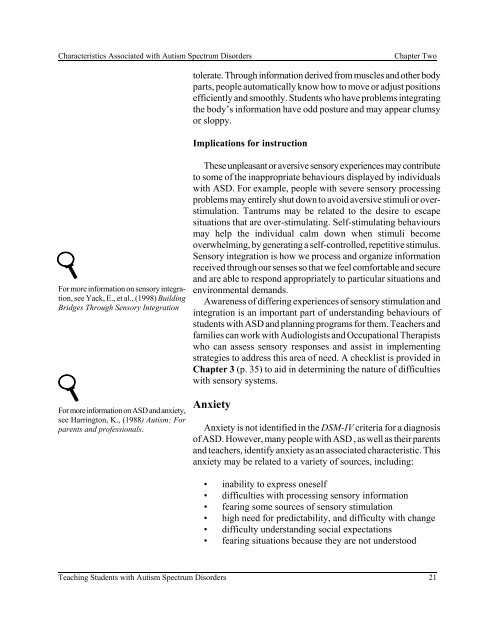Teaching Students with Autism Spectrum Disorders
Teaching Students with Autism Spectrum Disorders
Teaching Students with Autism Spectrum Disorders
Create successful ePaper yourself
Turn your PDF publications into a flip-book with our unique Google optimized e-Paper software.
Characteristics Associated <strong>with</strong> <strong>Autism</strong> <strong>Spectrum</strong> <strong>Disorders</strong> Chapter Two<br />
For more information on sensory integration,<br />
see Yack, E., et al., (1998) Building<br />
Bridges Through Sensory Integration<br />
For more information on ASD and anxiety,<br />
see Harrington, K., (1988) <strong>Autism</strong>: For<br />
parents and professionals.<br />
tolerate. Through information derived from muscles and other body<br />
parts, people automatically know how to move or adjust positions<br />
efficiently and smoothly. <strong>Students</strong> who have problems integrating<br />
the body’s information have odd posture and may appear clumsy<br />
or sloppy.<br />
Implications for instruction<br />
These unpleasant or aversive sensory experiences may contribute<br />
to some of the inappropriate behaviours displayed by individuals<br />
<strong>with</strong> ASD. For example, people <strong>with</strong> severe sensory processing<br />
problems may entirely shut down to avoid aversive stimuli or overstimulation.<br />
Tantrums may be related to the desire to escape<br />
situations that are over-stimulating. Self-stimulating behaviours<br />
may help the individual calm down when stimuli become<br />
overwhelming, by generating a self-controlled, repetitive stimulus.<br />
Sensory integration is how we process and organize information<br />
received through our senses so that we feel comfortable and secure<br />
and are able to respond appropriately to particular situations and<br />
environmental demands.<br />
Awareness of differing experiences of sensory stimulation and<br />
integration is an important part of understanding behaviours of<br />
students <strong>with</strong> ASD and planning programs for them. Teachers and<br />
families can work <strong>with</strong> Audiologists and Occupational Therapists<br />
who can assess sensory responses and assist in implementing<br />
strategies to address this area of need. A checklist is provided in<br />
Chapter 3 (p. 35) to aid in determining the nature of difficulties<br />
<strong>with</strong> sensory systems.<br />
Anxiety<br />
Anxiety is not identified in the DSM-IV criteria for a diagnosis<br />
of ASD. However, many people <strong>with</strong> ASD , as well as their parents<br />
and teachers, identify anxiety as an associated characteristic. This<br />
anxiety may be related to a variety of sources, including:<br />
• inability to express oneself<br />
• difficulties <strong>with</strong> processing sensory information<br />
• fearing some sources of sensory stimulation<br />
• high need for predictability, and difficulty <strong>with</strong> change<br />
• difficulty understanding social expectations<br />
• fearing situations because they are not understood<br />
<strong>Teaching</strong> <strong>Students</strong> <strong>with</strong> <strong>Autism</strong> <strong>Spectrum</strong> <strong>Disorders</strong> 21

















